
The Ministry of New & Renewable Energy (MNRE) has initiated the consultancy firm engagement process for developing a long-term vision, implementation plan, road map and institutional framework for implementing the ambitious ‘One Sun One World One Grid’ plan. U
Under the One Sun One World One Grid (OSOWOG) programme, India envisages to have an inter-connected power transmission grid across nations for the supply of clean energy, according to the request for proposal floated by the MNRE this week.
The vision behind the One Sun One World One Grid mantra is ‘The Sun Never Sets’ and is a constant at some geographical location, globally, at any given point of time.
With India at the fulcrum, the solar spectrum can easily be divided into two broad zones viz. far East which would include countries like Myanmar, Vietnam, Thailand, Lao, Cambodia etc. and far West which would cover the Middle East and the Africa Region, it stated.
The Ministry of New and Renewable Energy (MNRE) has a critical role to play in synergizing over 140 countries, across the far east and the far west regions, to build consensus, launch energy policy imperatives and set up a framework for such a global cooperation, it added.
India, through the OSOWOG initiative, plans to take another leap towards building a global ecosystem of interconnected renewable energy resources that are seamlessly shared for mutual benefits and global sustainability, it stated.
The OSOWOG would have three phases. In first phase Phase I, Middle East, South Asia and South East Asia would be interconnected.
In the second phase, solar and other renewable energy resources rich regions would be interconnected. In the third phase would vie for global interconnection of the power transmission grid to achieve the One Sun One World One Grid vision.
An interconnected grid would help all the participating entities in attracting investments in renewable energy sources as well as utilizing skills, technology and finances, it stated.
Resulting economic benefits would positively impact poverty alleviation and support in mitigating water, sanitation, food and other socioeconomic challenges. Further, the proposed integration would lead to reduced project costs, higher efficiencies and increased asset utilization for all the participating entities, it stated.

